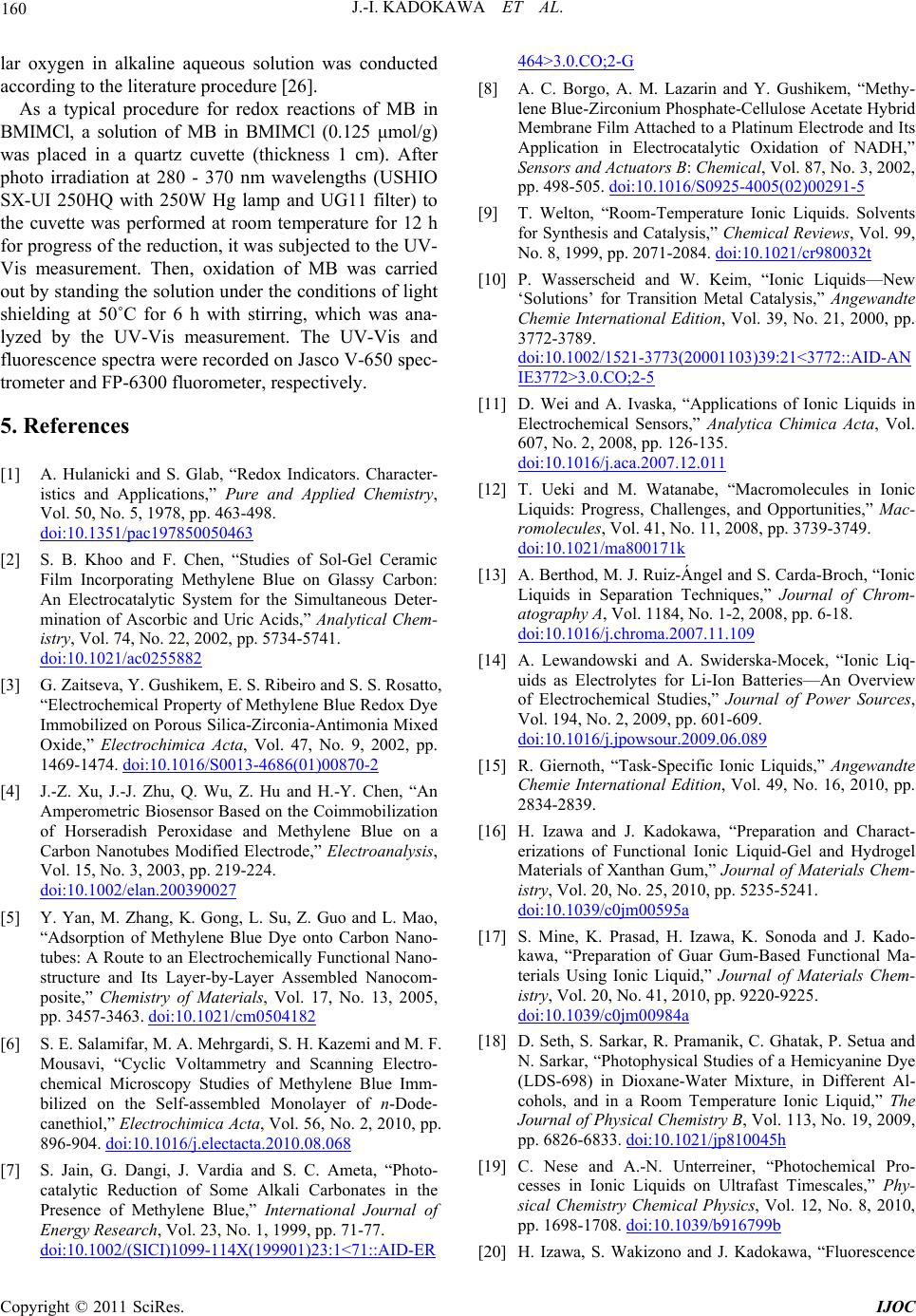
J.-I. KADOKAWA ET AL.
160
lar oxygen in alkaline aqueous solution was conducted
according to the literature procedure [26].
As a typical procedure for redox reactions of MB in
BMIMCl, a solution of MB in BMIMCl (0.125 μmol/g)
was placed in a quartz cuvette (thickness 1 cm). After
photo irradiation at 280 - 370 nm wavelengths (USHIO
SX-UI 250HQ with 250W Hg lamp and UG11 filter) to
the cuvette was performed at room temperature for 12 h
for progress of the reduction, it was subjected to the UV-
Vis measurement. Then, oxidation of MB was carried
out by standing the solution under the conditions of light
shielding at 50˚C for 6 h with stirring, which was ana-
lyzed by the UV-Vis measurement. The UV-Vis and
fluorescence spectra were recorded on Jasco V-650 spec-
trometer and FP-6300 fluorometer, respectively.
5. References
[1] A. Hulanicki and S. Glab, “Redox Indicators. Character-
istics and Applications,” Pure and Applied Chemistry,
Vol. 50, No. 5, 1978, pp. 463-498.
doi:10.1351/pac197850050463
[2] S. B. Khoo and F. Chen, “Studies of Sol-Gel Ceramic
Film Incorporating Methylene Blue on Glassy Carbon:
An Electrocatalytic System for the Simultaneous Deter-
mination of Ascorbic and Uric Acids,” Analytical Chem-
istry, Vol. 74, No. 22, 2002, pp. 5734-5741.
doi:10.1021/ac0255882
[3] G. Zaitseva, Y. Gushikem, E. S. Ribeiro and S. S. Rosatto,
“Electrochemical Property of Methylene Blue Redox Dye
Immobilized on Porous Silica-Zirconia-Antimonia Mixed
Oxide,” Electrochimica Acta, Vol. 47, No. 9, 2002, pp.
1469-1474. doi:10.1016/S0013-4686(01)00870-2
[4] J.-Z. Xu, J.-J. Zhu, Q. Wu, Z. Hu and H.-Y. Chen, “An
Amperometric Biosensor Based on the Coimmobilization
of Horseradish Peroxidase and Methylene Blue on a
Carbon Nanotubes Modified Electrode,” Electroanalysis,
Vol. 15, No. 3, 2003, pp. 219-224.
doi:10.1002/elan.200390027
[5] Y. Yan, M. Zhang, K. Gong, L. Su, Z. Guo and L. Mao,
“Adsorption of Methylene Blue Dye onto Carbon Nano-
tubes: A Route to an Electrochemically Functional Nano-
structure and Its Layer-by-Layer Assembled Nanocom-
posite,” Chemistry of Materials, Vol. 17, No. 13, 2005,
pp. 3457-3463. doi:10.1021/cm0504182
[6] S. E. Salamifar, M. A. Mehrgardi, S. H. Kazemi and M. F.
Mousavi, “Cyclic Voltammetry and Scanning Electro-
chemical Microscopy Studies of Methylene Blue Imm-
bilized on the Self-assembled Monolayer of n-Dode-
canethiol,” Electrochimica Acta, Vol. 56, No. 2, 2010, pp.
896-904. doi:10.1016/j.electacta.2010.08.068
[7] S. Jain, G. Dangi, J. Vardia and S. C. Ameta, “Photo-
catalytic Reduction of Some Alkali Carbonates in the
Presence of Methylene Blue,” International Journal of
Energy Research, Vol. 23, No. 1, 1999, pp. 71-77.
doi:10.1002/(SICI)1099-114X(199901)23:1<71::AID-ER
464>3.0.CO;2-G
[8] A. C. Borgo, A. M. Lazarin and Y. Gushikem, “Methy-
lene Blue-Zirconium Phosphate-Cellulose Acetate Hybrid
Membrane Film Attached to a Platinum Electrode and Its
Application in Electrocatalytic Oxidation of NADH,”
Sensors and Actuators B: Chemical, Vol. 87, No. 3, 2002,
pp. 498-505. doi:10.1016/S0925-4005(02)00291-5
[9] T. Welton, “Room-Temperature Ionic Liquids. Solvents
for Synthesis and Catalysis,” Chemical Reviews, Vol. 99,
No. 8, 1999, pp. 2071-2084. doi:10.1021/cr980032t
[10] P. Wasserscheid and W. Keim, “Ionic Liquids—New
‘Solutions’ for Transition Metal Catalysis,” Angewandte
Chemie International Edition, Vol. 39, No. 21, 2000, pp.
3772-3789.
doi:10.1002/1521-3773(20001103)39:21<3772::AID-AN
IE3772>3.0.CO;2-5
[11] D. Wei and A. Ivaska, “Applications of Ionic Liquids in
Electrochemical Sensors,” Analytica Chimica Acta, Vol.
607, No. 2, 2008, pp. 126-135.
doi:10.1016/j.aca.2007.12.011
[12] T. Ueki and M. Watanabe, “Macromolecules in Ionic
Liquids: Progress, Challenges, and Opportunities,” Mac-
romolecules, Vol. 41, No. 11, 2008, pp. 3739-3749.
doi:10.1021/ma800171k
[13] A. Berthod, M. J. Ruiz-Ángel and S. Carda-Broch, “Ionic
Liquids in Separation Techniques,” Journal of Chrom-
atography A, Vol. 1184, No. 1-2, 2008, pp. 6-18.
doi:10.1016/j.chroma.2007.11.109
[14] A. Lewandowski and A. Swiderska-Mocek, “Ionic Liq-
uids as Electrolytes for Li-Ion Batteries—An Overview
of Electrochemical Studies,” Journal of Power Sources,
Vol. 194, No. 2, 2009, pp. 601-609.
doi:10.1016/j.jpowsour.2009.06.089
[15] R. Giernoth, “Task-Specific Ionic Liquids,” Angewandte
Chemie International Edition, Vol. 49, No. 16, 2010, pp.
2834-2839.
[16] H. Izawa and J. Kadokawa, “Preparation and Charact-
erizations of Functional Ionic Liquid-Gel and Hydrogel
Materials of Xanthan Gum,” Journal of Materials Chem-
istry, Vol. 20, No. 25, 2010, pp. 5235-5241.
doi:10.1039/c0jm00595a
[17] S. Mine, K. Prasad, H. Izawa, K. Sonoda and J. Kado-
kawa, “Preparation of Guar Gum-Based Functional Ma-
terials Using Ionic Liquid,” Journal of Materials Chem-
istry, Vol. 20, No. 41, 2010, pp. 9220-9225.
doi:10.1039/c0jm00984a
[18] D. Seth, S. Sarkar, R. Pramanik, C. Ghatak, P. Setua and
N. Sarkar, “Photophysical Studies of a Hemicyanine Dye
(LDS-698) in Dioxane-Water Mixture, in Different Al-
cohols, and in a Room Temperature Ionic Liquid,” The
Journal of Physical Chemistry B, Vol. 113, No. 19, 2009,
pp. 6826-6833. doi:10.1021/jp810045h
[19] C. Nese and A.-N. Unterreiner, “Photochemical Pro-
cesses in Ionic Liquids on Ultrafast Timescales,” Phy-
sical Chemistry Chemical Physics, Vol. 12, No. 8, 2010,
pp. 1698-1708. doi:10.1039/b916799b
[20] H. Izawa, S. Wakizono and J. Kadokawa, “Fluorescence
Copyright © 2011 SciRes. IJOC